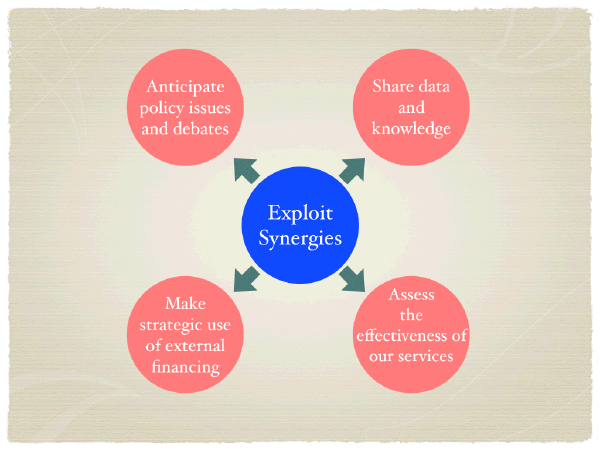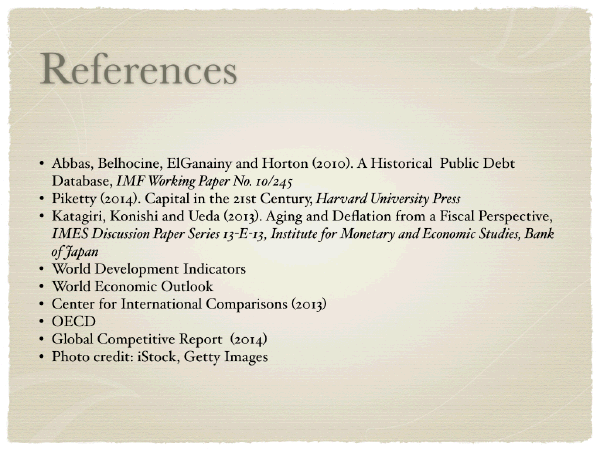Closing Remarks to the Fiscal Affairs Department's 50th Anniversary Conference on "Fiscal Affairs, Past and Future" by Vitor Gaspar, Director of Fiscal Affairs Department
December 5, 2014
Washington, DC
December 5, 2014
As prepared for delivery
As the conference is coming to an end, I want to thank you for coming and participating in Fiscal Affairs Department (FAD)’s 50th anniversary conference.
My talk will be about FAD and Public Finances for the 21st century.
My talk is organized in three parts:
First, looking back, I will argue that FAD has responded to the challenges of the times.
Second, looking forward, I will argue—as was clear from today’s conference—that public finances will be at the top of the policy agenda.
And third, I will conclude with a claim that FAD will build on synergies with stakeholders and across work streams to stay as a center of excellence in public finance and to play a leading role in shaping the policy agenda and capacity building on structural fiscal issues.

As we look to FAD’s future, we are inspired by FAD’s ability over the years to focus on the challenges of the times. Today, Vito, Teresa and Carlo have reminded us of the changing emphasis of fiscal policy over time. They also remind us that many fiscal issues are timeless.
The IMF was created as part of a peacetime system of international organizations to solve disputes through dialogue. International cooperation would substitute for war.
At the Fund’s inception, fiscal policy was not a matter for international cooperation. Instead it was regarded as a centerpiece of national macroeconomic policy making.
But in the 1960s, the IMF’s membership expanded into newly independent states in Africa and Asia. These countries called for assistance to establish their fiscal institutions.
The IMF eventually created FAD in 1964. Here you see a picture from FAD’s first technical assistance report in 1965 on tax administration in Liberia. Technical assistance and capacity building in IMF member countries lies at the root of FAD. It is in its DNA.
Since then, FAD has continued to respond to the challenges of the times.
It extended its coverage of technical assistance to all regions around the world.
It expanded its work from tax policy issues into other areas of public finance.
It strengthened its research activities, for example on the impact of inflation on tax revenues, which came to be known as the Tanzi effect.
It provided support to countries seeking financial stability following crisis or countries needing structural reform.
It also increased its focus on fiscal sustainability and crisis prevention.
Going forward, public finances will be at the top of the policy agenda.
Policy makers need to deal with the legacies from the financial crisis.
They also need to deal with new evolutionary dynamics that will transform public finances.
I will give you a couple of examples. I could give you many. The presentation that I will make available at the end of this session has some supplementary material. I will start with high public debt, and then cover others more briefly.

In history, the build-up of public debt was mostly associated with war.
This chart shows debt to GDP ratios for advanced and emerging markets from 1880 to 2014.
As you can see, WWI raised debt significantly in several advanced economies. Debt in the U.K. climbed to 196 percent of GDP. In France, it reached 237 percent of GDP.
Debt levels fell somewhat before rising again during the Great Depression.
WWII again brought debt up, this time to 270 percent of GDP in the U.K., and 120 percent of GDP in the United States. The IMF started in times of very high public debt.
The IMF started in times of very high public debt.
Debt to GDP fell dramatically in the aftermath of the war.
How?
Real interest rates in many countries were kept low. Sometimes even negative.
Monetary and financial policies were subordinated to the priority to keep Treasury financing costs low.
Strong post-war economic growth also contributed.
By the 1960s new pressures emerged.
In the U.S., for example, finances were strained by the Vietnam War and Great Society programs.
The late 1960s opened the way to the Great Inflation.
The Bretton Woods system collapsed in 1971.
The oil price shocks in the 1970s further impacted finances.
General government deficits became high and persistent.
By the mid-1970s, public debt was on an upward trajectory.
The global financial crisis led public debt to levels not seen since WWII.
Debt in the U.S., U.K. and several Euro Area countries approached 100 percent of GDP.
How can policymakers bring debt down to safer levels? What are the incentives within political systems that push or resist fiscal reform?
We will explore such questions and those of the “Political Economy of High Public Debt” at the Fiscal Forum this coming Spring.

Another major issue is income inequality.
In 1944, the main focus was divergence across countries. The main question was “how can poorer countries catch up to richer ones?” Since then we have recorded many inspiring stories of successful convergence. In the last few years LIDCs have weathered the economic and financial headwinds relatively well.
More recently, the focus has turned to inequality within national borders.
In his book “Capital in the Twenty-First Century”, Piketty documents rising inequality in many countries. His focus on the income share of the top percentile or the top decile caught up as a political slogan. A rare distinction for an academic. This chart shows income inequality in the U.S. from 1910 to 2010. As you can see, income inequality in 2010 is at levels last seen in the 1920s.
Bank bailouts during the crisis, fiscal adjustment, and high unemployment in many countries have put pressure on governments to address income inequality.
The question now is “how should policies be designed to ensure inclusive growth?”
FAD has done much work on this topic over the years. We explore the issue further in our upcoming book on inequality and the role of fiscal policy, to be released next Fall.

Let me turn to demographic changes.
Declining fertility rates have significant effects on public finances.
This chart shows the fertility rate in Japan from 1965 to its forecast for 2060. It has fallen well below the replacement rate. The chart also shows that fertility rate forecasts are highly uncertain, with sizeable revisions. Just look at the 1976 forecast. The fertility rate was supposed to recover. It did not. This was repeated in 1986 and 1992. The long run effects on population dynamics are profound.
Is Japan an example of what lies ahead for the rest of the world? Will we be dealing with the public finance implications of declining populations?
This is the theme of our forthcoming Staff Discussion Note on the “Fiscal Consequences of Shrinking Populations”, to be issued mid-next year.

Gender is another important issue drawing our attention.
Women make up a little over half the world’s population. However, female labor force participation is sharply below male participation in many countries. This chart shows male labor force participation on the x-axis and female participation on the y-axis. You can see that the distance to the diagonal is remarkably high in many cases.
Higher female labor force participation can boost growth by mitigating the impact of a shrinking workforce. Better opportunities for women can also contribute to broader economic development.
How can tax and expenditure policies be designed to effectively boost women’s economic opportunities?
We can look to the examples of Brazil and Sweden.
Over the past two decades, Brazil’s female labor force participation rate increased by 15 percentage points to almost 60 percent. This was achieved through targeted reforms that removed restrictions in access to resources and entitlements for women.
In Sweden, concerns with population dynamics and the possibility of shrinking population were already present in the 1930s. Now Sweden has a fertility rate at about the replacement ratio. Also, the gap between male and female labor force participation rate is only 6 percent. This is attributed to a generous parental leave policy, child care coverage, and job guarantees.
In the coming months, the IMF will analyze gender issues in a number of countries.
Let me now turn to the concluding part of my talk: FAD’s strategy going forward.
FAD aims to play a leading role in setting the global policy agenda on structural fiscal issues.
We will build on FAD’s success by working better together.

We engaged in an extensive consultation process within FAD and with external stakeholders to identify the strong points of FAD and how to bring FAD to the next level.
We identified 5 strategic priorities.
At the center of the strategy: synergies.
We will take advantage of synergies within FAD, within the Fund, and with its membership.
We will take advantage of synergies with donors, academics, and international organizations.
Synergies will allow us to meet our other strategic priorities.

Synergies will build on FAD’s expertise across a wide and diverse range of issues. We could have listed more but ran out of slide space.
FAD has the largest concentration of fiscal experts under one roof.

We will also build synergies drawing on our insight on “how to” implement fiscal reforms.
FAD engages with countries across the world through technical assistance advice and policy advice in conjunction with area department country teams. This map shows the countries where FAD has provided technical assistance or where an FAD fiscal economist participates in country teams.
We will continue to serve as the center of interaction on fiscal issues within the Fund. This is an emphasis that Teresa gave to the department during her tenure. She enhanced significantly FAD’s support to country teams. We continue to see this at the core of our work.
We want to anticipate policy issues and debates. Again we will use synergies inside and outside FAD.

As you can see from this slide, we have already put in place the adequate analytical tools in order to do so.
FAD provides important contributions to the global policy debate.
This through numerous publications, as noted in this slide.
FAD has also increased its participation in the global policy debate through the Fiscal Monitor, established in 2009 under Carlo’s leadership.
The department also promotes fiscal policy dialogue between our members through the Fiscal Forum—a network of senior ministry of finance officials who meet every Spring.

We will advance our research agenda by focusing on 5 analytical priorities. You will notice that these priorities tie in with the challenges that I highlighted earlier in my presentation.
These are:
- Fiscal policy and inclusive growth
- Political economy of fiscal policy and reform
- Fiscal risks and fiscal anchors
- Major long-term trends and their impact on public finances
- Improving fiscal management

As I contemplated on the political economy of fiscal policy, I looked for a reference: Public Choice Analysis in Historical Perspective by Alan Peacock. To my amusement, when I received the book from the library, I saw that Vito was the first to check the book from what was still the Fiscal Library.

To remain at the frontier of the fiscal policy agenda, we will launch an annual lecture series in honor of Richard Goode. We will call on top academics to contribute, and invite a broad audience of policy makers, academics, and representatives from international organizations.
We want to enrich our policy advice by making use of the wealth of data from our technical assistance work and close links with our members on fiscal issues.
Let me illustrate with an example of an ongoing project, the Revenue Administration Fiscal Information Tool, RA-FIT.
RA-FIT provides a single platform for data gathering and dissemination on revenue administration performance at an international level. RA-FIT includes data related to tax and customs administration from 86 administrations. We eventually want to cover all 188 IMF members.
We will continue to develop this priority, including through a dedicated data management team in the department.
We aim for the highest effectiveness of our services through a results oriented approach.
We have a clear work program in this direction.
For example, our reports to donors are adding greater focus on results based management. This included a stronger focus on project results and a clearer assessment of key project risks.
We will continue to build an understanding of the links between technical assistance delivery and outcomes. This will increase the impact of advice on the achievement of long-term development goals.

Let me now give you a flavor of how we see synergies working, using as an example our ongoing work on the efficiency of public investment.
Growth is lackluster in many countries. The chart shows potential GDP forecasts for 2014 and 2015 across different WEO vintages starting in October 2010. As you can see, potential GDP growth has been consistently revised downward.
An increase in infrastructure investment could benefit many countries. It can raise output immediately by creating jobs. It can raise output over the medium-term by enhancing productive capacity.

However, the benefits of public investment will only come if it is efficiently planned, allocated, and executed. This requires strong public investment management institutions.
This chart shows on the x-axis the real public capital stock per capita. On the y-axis, an often-used measure of the quality of infrastructure from the Global Competiveness Report.
As you can see, some countries do not achieve the quality of infrastructure they could, given their high public capital stocks. This helps illustrate that in many countries, public investment can be done better. Common problems include weak project appraisal, delays in completing projects, and cost overruns.
But how, specifically, can government strengthen their public investment management practices?
This is precisely the focus of FAD’s work. We are carrying out a new analysis of the role of fiscal institutions in promoting efficient public investment. To do so, we are exploiting synergies within FAD, bringing together our expertise on public financial management and expenditure policy.
Our analysis identifies key public investment management institutions for efficient planning, allocation, and execution of investment. It then assesses their impact on a range of indicators of performance (such as the volatility of investment spending and execution of investment budgets).
We rely on diverse methodological approaches, including 36 case studies. Our analysis will also allow us to build a tool that we can use to provide technical assistance.

Let me leave you with this last image. It is an image that we often use as our banner in FAD: The Effects of Good Government on City Life, fresco painted by Ambrogio Lorenzetti in Siena from 1338 to 1339.
Interestingly, this fresco was painted on the eve of the first true international debt crisis. Edward III of England had borrowed heavily from Florentine bankers to finance his wars with France. After a series of military failures, in 1340, Edward defaulted on some of his debts. That led to the ruin of the House of Bardi and Peruzzi.
Many fiscal issues are timeless.
We at FAD have an ambitious work plan ahead. We will strive to be a leading center of excellence on public finances in the global economy. We will strive to provide the highest quality advice to promote sustainable and equitable growth.
Let me conclude:
FAD will continue to support countries around the world in achieving Good Government. Lorenzetti’s fresco shows early fourteenth-century citizens engaged in diverse economic activities such as constructing new buildings, selling merchandise, teaching, baking, banking. As you can see from Lorenzetti’s painting, Good Government makes happiness and prosperity for the people possible. That is why it is FAD’s banner. It shows we care.

Before I close the Conference: Thank you!
I want to thank Vito, Teresa and Carlo; all speakers and participants that made this event memorable. And I want to express my deep appreciation to all FAD for 50 memorable years; and their commitment to excellence going forward.
Last but not least, I would like to thank the organizers of the event for their excellent job in making this conference a success. In particular, I thank Geremia Palomba, Debra Adams, Kerstin Gerling, Muriel Jolivert, Marina Marinkov, Jimmy McHugh, Carlos Mulas Granados, Masahiro Nozaki, Juliana Peña, and Beelan Yonas. I also thank Laura Jaramillo for coordinating this presentation and Haoyu Wang who helped her in putting it together.

IMF COMMUNICATIONS DEPARTMENT
| Public Affairs | Media Relations | |||
|---|---|---|---|---|
| E-mail: | publicaffairs@imf.org | E-mail: | media@imf.org | |
| Fax: | 202-623-6220 | Phone: | 202-623-7100 | |







